|
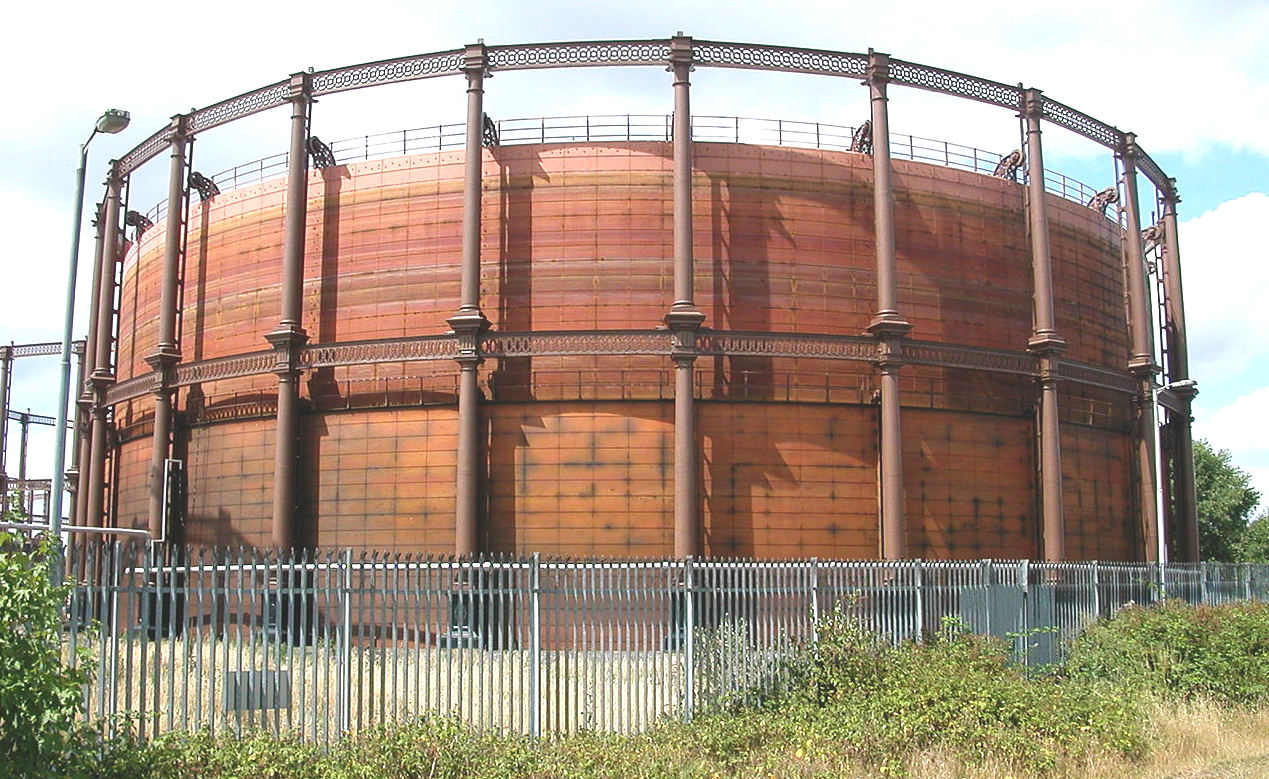
A
MODERN MULTI PURPOSE GAS HOLDER - In days gone by town gas was stored in
large steel floating cylinders called gasometers or gas holders, like that
shown above. Every town had one, with cities having
several. These mammoth gas holders have all but disappeared, as relics of a bygone
age, except where gas is used for industrial purposes in large volumes, such
as to make steel. A modern version of this concept, is the SmartNet,
versatile service station, except that SmartNet units are not unsightly -
and unlike the steel structure above, are crammed full of essential smart
tech.
In 2008 the UK could only store around 4% of its annual gas consumption, compared to Germany and France who can store over 20%.
Through
1960 -1970 it was thought that gas holders could be replaced with high-pressure bullets (a cylindrical pressure vessel with hemispherical ends). However, regulations
consigned all new bullets to be built several miles out of towns and cities.
The security of storing large amounts of high-pressure natural gas above ground made them unpopular with local people and councils. Bullets are gradually being decommissioned.
Natural gas is stored in liquid form throughout the world.
More
recently gas is stored in large underground reservoirs such as salt caverns.
Though, line-packing is the preferred method.
AS
OF 2008 - A few gasometers are in use in the UK - apparently there's a working gas holder in the east of Oxford, yards from the Cowley plant.
But most have not been used for many years.
They became common in the last century because 'town' gas for domestic use was locally manufactured from coal - it needed to be stored.
Gasometers were made obsolete by the high pressure underground pipelines that deliver natural gas - the National Transmission System. Natural gas was discovered in the North Sea in the 1960s.
Transco planned to dismantle nearly all of its non-listed 550 gasometers by 2009.
Gasometers require expensive maintenance - and the authorities are not keen on large containers of gas in urban areas, either.
"There are, on average, three or four large gas escapes every year from gasholders, which could lead to a major incident if the gas found an ignition source." wrote Geoffrey Podger, Chief Executive, Health and Safety Executive, in November 2007.
Obviously, hydrogen presents a similar danger, but if properly ventilated
and monitored with sensors, installations would be as safe as petrol, at
petrol stations.
A gas holder or gasholder, also known as a gasometer, is a large
floating container in which natural gas or town gas is stored near atmospheric pressure at ambient temperatures. The volume of the container
dictates the quantity of stored gas, with pressure coming from the weight of
what is essentially, a giant movable cap or piston that floats on an even
larger diameter pool of water. Typical volumes for large gas holders are about 50,000 cubic metres (1,800,000 cu ft), with 60 metres (200 ft) diameter structures.
Simple, but effective.
Gas holders now tend to be used for balancing purposes, to ensure that gas pipes can be operated within a safe range of pressures, rather than for
storing gas for later use. They act like capacitors in electrical circuits, smoothing
delivery and flow. As far as we know, there are no units like this to
balance hydrogen pipelines at the moment. Unlike
the SmartNet™
energy storage and load leveling units, gas holders cannot release energy as
electricity, they simply store hydrogen as potential energy. Whereas, SmartNet
stations can also supply hydrogen as a gas, or electricity; being dual fuel. So
that is electricity
and gas from one location - for a smarter energy solution. Being flat-packs,
means faster installation and massive infrastructure saving from mass
production. The
world needs to replace 600,000 diesel/petrol service stations by 2040, to
help put the brakes on global
warming. As
of 2022 no energy company has expressed interest in the system. Most, don't
seem to recognise the advantages, or most likely will not invest in anything
that needs development - because of the grant system, that wants near-to
projects as short-termist policies prevail. The
2020s are a sad time for global warming scientists. Despite rising
sea levels flooding low islands
and arctic ice melt, and desertification running rampant. It may be the same
in the 2030s and 2040s, until bushfires
become more frequent, and coal
burning is finally outlawed. Food
for thought!
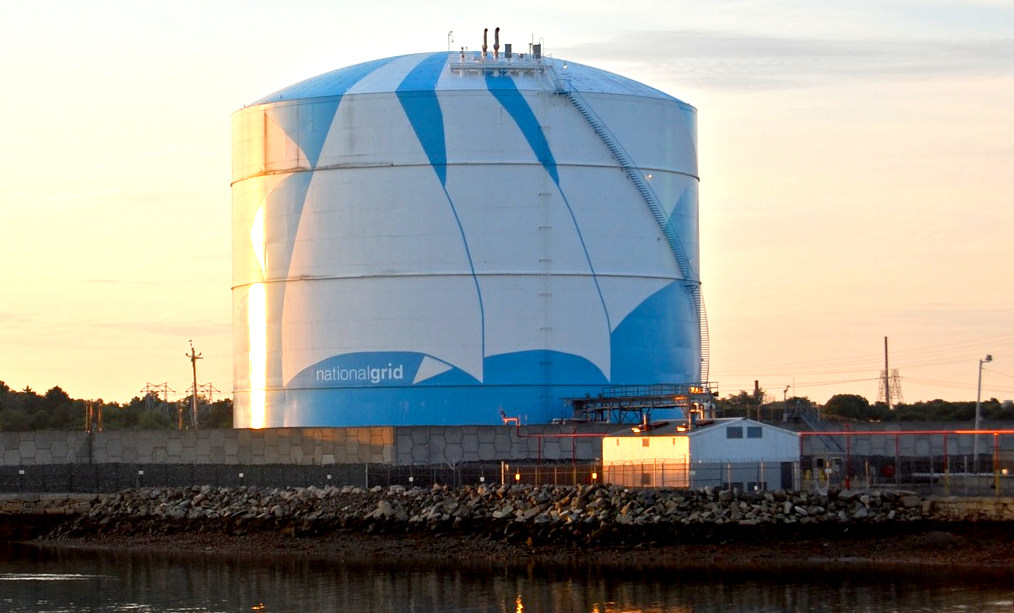
MASSACHUSETTS
- LNG tank as part of the National Grid in the USA.
LOAD LEVELLING
A gas holder provided storage for purified, metered gas. It acted as a buffer, removing the need for continuous gas production. The weight of the gas holder lift (cap) controlled the pressure of the gas in the mains and provided back pressure for the gas-making plant.
Gas holders hold a large advantage over other methods of storage. They are the only storage method that keeps gas at district pressure (the pressure required in local gas mains). Once the district low pressure switch falls and the booster fans come on, the gas in these holders can be at homes, being used, in a very short period of time. Gas is stored in the holder throughout the day, when little gas is being used. At about 5 p.m. there is a rise in demand for gas and the holder comes down.
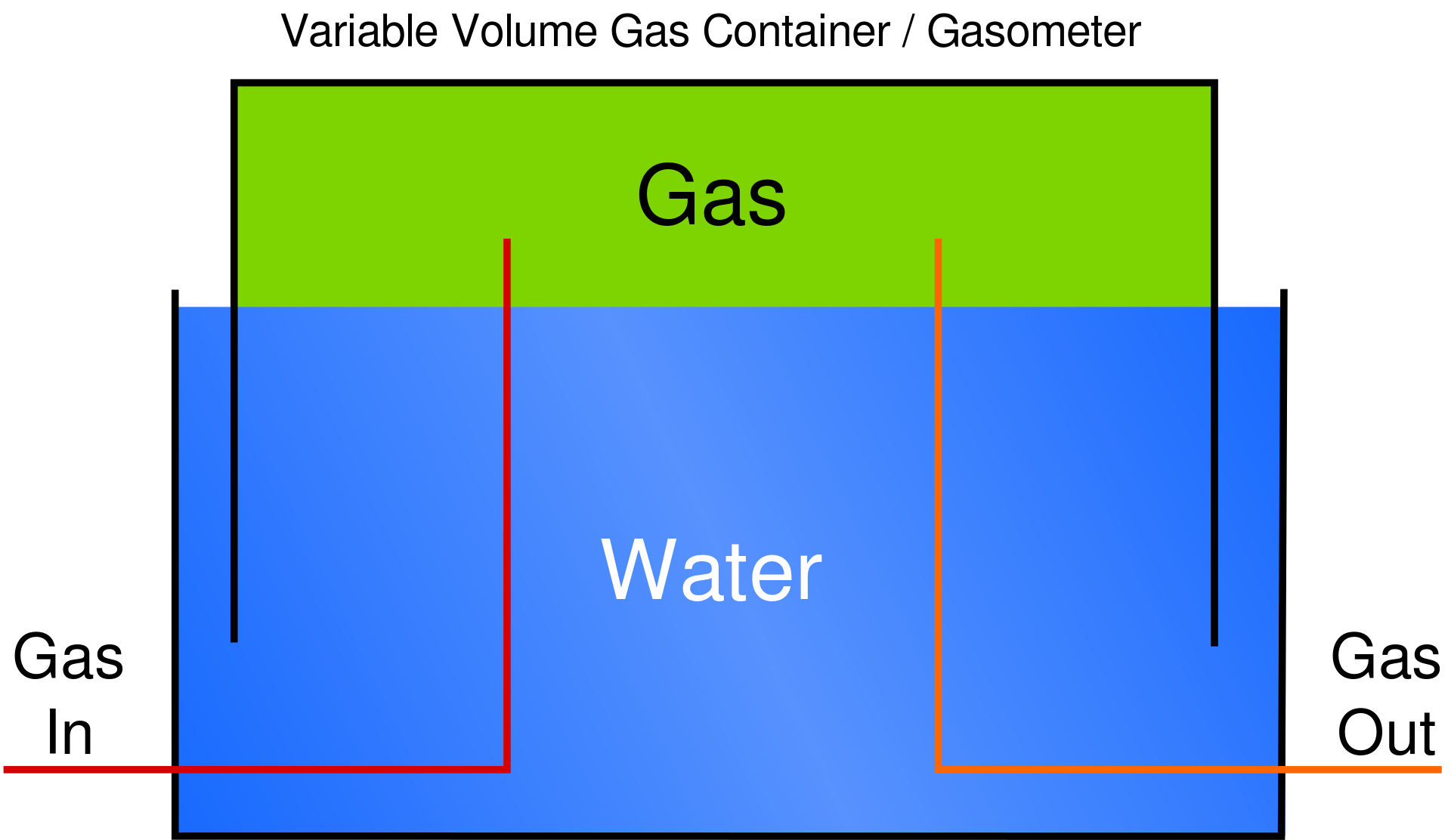
SINGLE
STAGE GAS HOLDER - This is the least complicated type of gasometer, using a
floating piston, or cap, with the seal being the skirt in the water that the
piston is floating on.
DESIGNS
There are two basic types of gas holder: the water-sealed and the rigid waterless.
The water-sealed gas holder consists of a tank of water that rises and falls to take the gas. A watered gas holder consisted of two parts: a deep tank of water used to provide a seal, and a closed vessel (the lift) that rises above the water as the gas volume increased.
Rigid waterless gas holders were a very early design that neither expanded or contracted. There are modern versions of the waterless gas holder, e.g. oil-sealed, grease-sealed and "dry seal" (membrane) types. They consist of a fixed cylinder capped by a moving piston.

BASF
- A gas holder site in Germany, showing the large floating silos and the
modern high pressure tanks, by way of contrast, old and new.
WATER SEALED (FLOATING PISTON0 GAS HOLDERS
The earliest Boulton and Watt gas holders had a single lift. The tank was above ground and was lined with wood; the lift was guided by tripods and cables. Pulleys and weights were supplied to regulate the gas pressure. Brick tanks were introduced in 1818, when a gas holder would have a capacity of 20,000 cubic feet (570 m3). The engineer John Malam devised a tank with a central rod-and-tube guide system.
Telescoping holders fall into two subcategories. The earlier of the telescoping variety were column-guided variations and were built from 1824. To guide the telescoping walls, or "lifts", they have an external fixed frame, visible at a fixed height at all times. A refinement was the guide frame gas holder, where the heavy columns were replaced by a lighter and more extensive framework. Vertical girders (standards) were intersected by horizontal girders and cross-braced. This could be bolted onto an underground or above-ground tank. The Cutler patented guide frame dispensed with the horizontal girders using diagonal triangulated framing instead. Cable-guided gas holders, invented by Pease in 1880, had a limited use, but were useful on unstable ground where the rigid systems could buckle and jam the lift.
Spiral-guided gas holders were built in the UK from 1890 until 1983. These have no frame, and each lift is guided by the one below, rotating as it goes up as dictated by helical runners.
Both telescoping types use the manometric property of water to provide a seal. The whole tank floats in a circular or annular water reservoir, held up by the roughly constant pressure of a varying volume of gas, the pressure determined by the weight of the structure, and the water providing the seal for the gas within the moving walls. Besides storing the gas, the tank's design serves to establish the pressure of the gas system. With telescoping (multiple-lift) tanks, the innermost tank has an approximately 1 ft × 2 ft (30 cm × 61 cm) lip around the outside of the bottom edge, called a cup, which picks up water as it rises above the reservoir water level. This immediately engages a downward lip on the inner rim of the next outer lift, called a dip or grip, and as this grip sinks into the cup, it preserves the water seal as the inner tank continues to rise until the grip grounds on the cup, whereupon further injection of gas will start to raise that lift as well. Holders were built with as many as four lifts. An extra flying lift could be retrofitted into column or frame gas holders. This was an additional inner tank that extended above the standards, when the infrastructure would support the extra shear forces and weight. Though not exclusively, spiral guides were used.
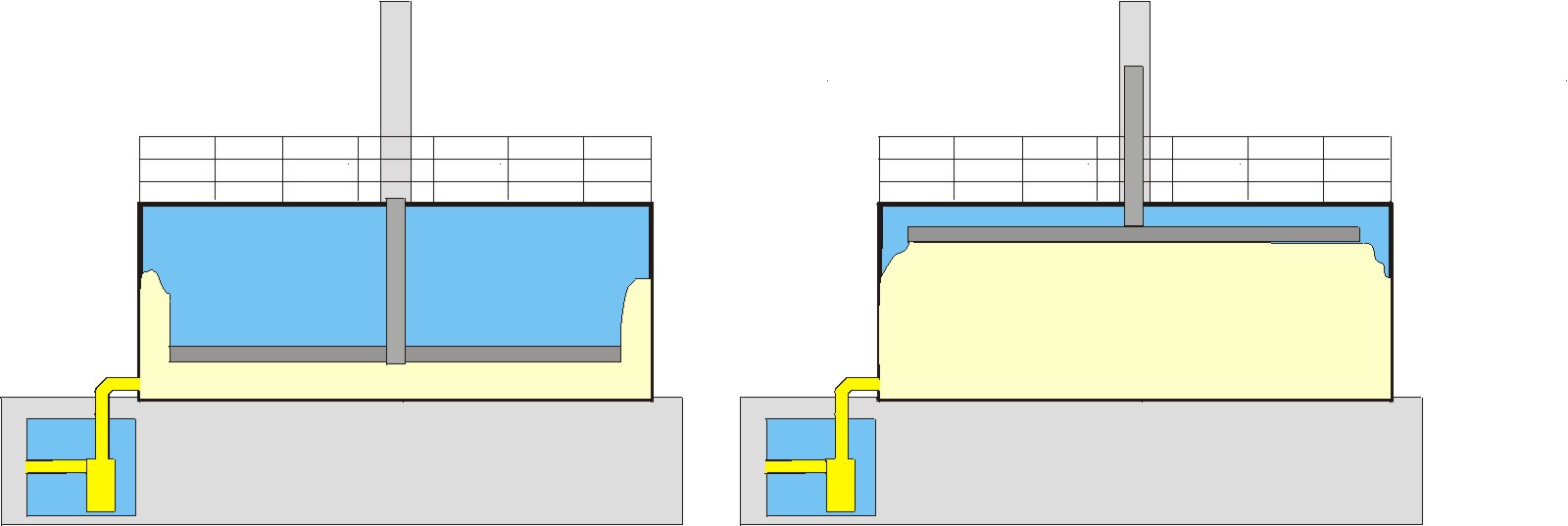
WIGGINS
- Dry seal gasometers used flexible membranes to contain the gas.
DRY SEAL GAS HOLDERS
Dry-seal gas holders have a static cylindrical shell, within which a piston rises and falls. As it moves, a grease seal, tar/oil seal or a sealing membrane which is rolled out and in from the piston keeps the gas from escaping. The MAN (Maschinenfabrik Augsburg-Nürnberg AG) was introduced in 1915: it was polygonal and used a tar/oil seal. The Klonne dry seal gas holder was circular: it used a grease seal. The dry-seal Wiggins gasholder was patented in 1952: it used a flexible curtain that was suspended from the piston. The largest low-pressure gas holders built was the Klonne gas holder built in 1938 in Gelsenkirchen. It was 147 metres (482 ft) high and 80 metres (260 ft) in diameter, which gave it a capacity of 594,000 cubic metres (21,000,000 cu ft). There was a MAN type, built in 1934 in Chicago with a capacity of 566,000 cubic metres (20,000,000 cu ft). MAN
are now working on cryogenic marine cylinders, to carry liquid hydrogen as a
fuel. Other high pressure cylinders (bullets) Type I have been looked at for
the Elizabeth Swann
trimaran, where an International team are looking to set a world record around
the world in 80 days. Hoping to launch by 2024, on the 150th anniversary
of Jules
Verne's 1974 prediction about hydrogen being the fuel of the future.
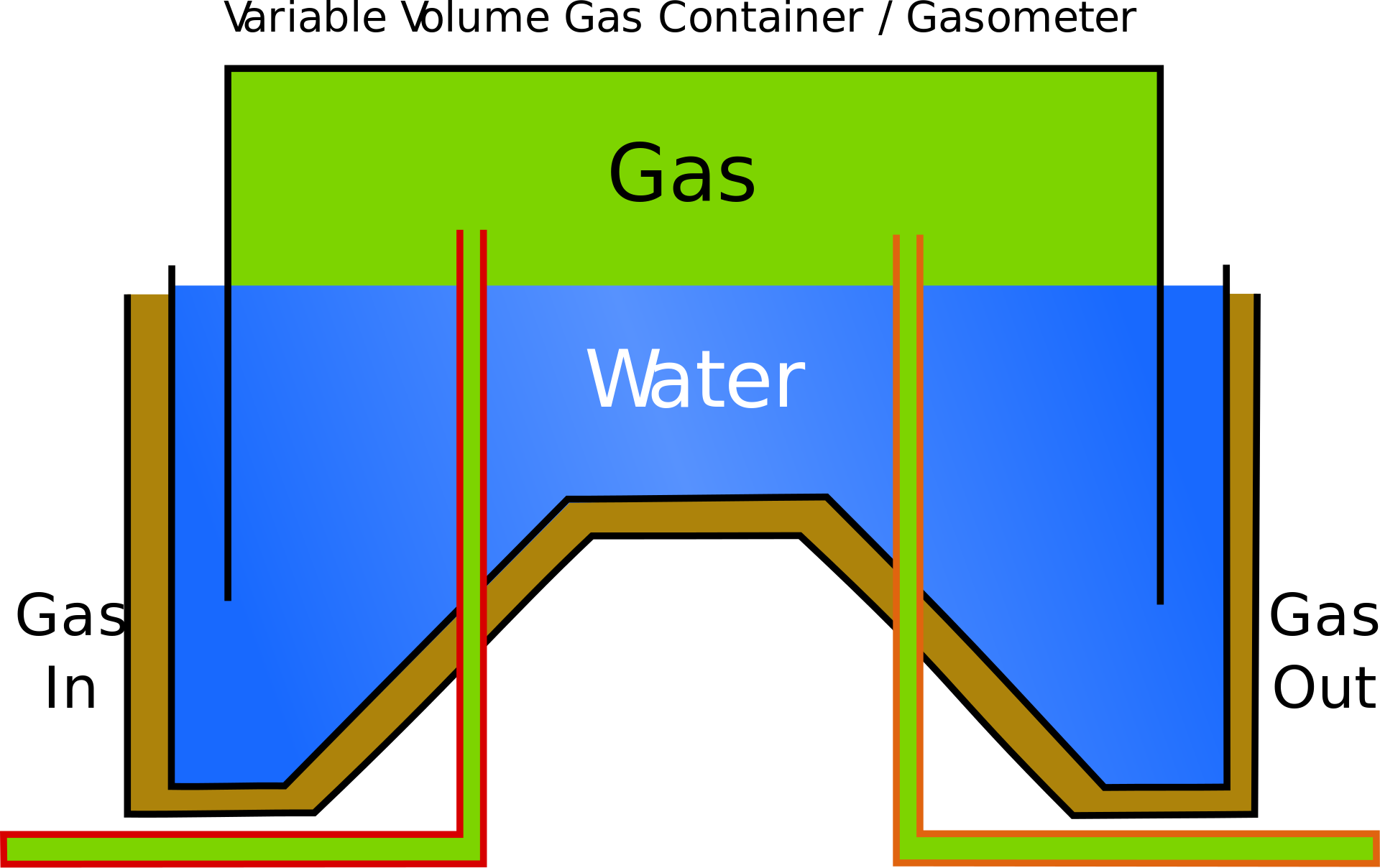
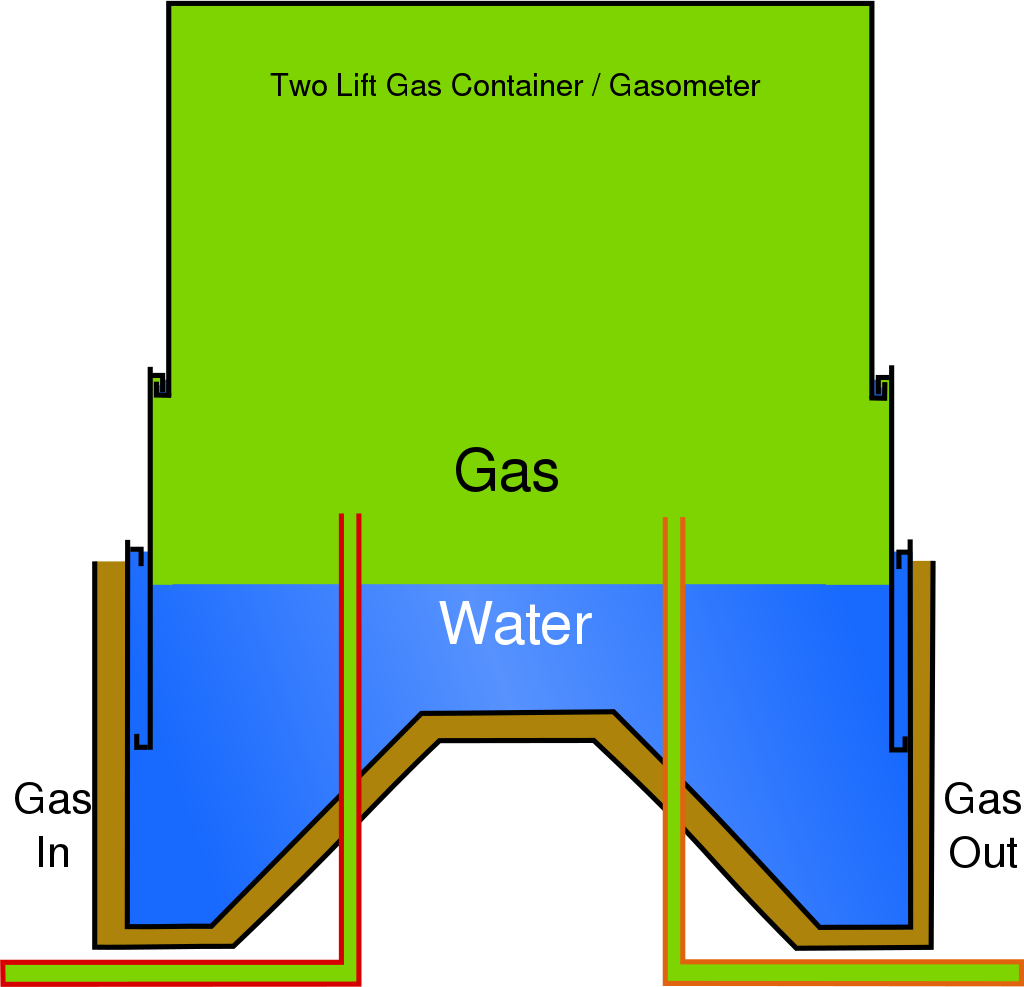
TWO
STAGE - A 2 stage gasometer in empty )collapsed) and full (expanded) conditions.
GEOGRAPHICAL VARIATION
EUROPE
The pollution associated with gasworks and gas storage makes the land difficult to reclaim for other purposes, but some gas holders, such as the Vienna Gasometers, have been converted into other uses such as living space and a shopping mall and historical archives for the city. Many sites, however, were never used for the production of 'town gas', therefore the land contamination is relatively low.
Gas holders have been a major part of the skylines of low-rise British cities for up to 200 years, due to their large distinctive shape and central location. They were originally used for balancing daily demand and generation of town gas. With the move to natural gas and construction of the national grid pipework, their use steadily diminished as the pipe network could both store gas under pressure, and eventually satisfy peak demand directly. London, Manchester, Sheffield, Birmingham, Leeds, Newcastle, Salisbury and Glasgow (which has the largest gasometers in the UK) are noted for having many gas holders.
Some of these gas holders have become listed buildings. The gas holders behind King's Cross station in London were specially dismantled when the new Channel Tunnel Rail Link was being created, with Gas holder No 8 being re-erected on a nearby site behind St Pancras station as part of a housing development. It has been fashioned into a park. Most gas holders are no longer used, and a program of dismantling is underway to release the land for reuse.
A gasworks in South Lotts, Dublin, Ireland, was converted into apartments.
In the past, holder stations would have an operator living on site controlling their movement. However, with the process control systems now used on these sites, such an operator is obsolete. The tallest gasometer in Europe is 117 metres (384 ft) tall and is located in Oberhausen.
In the UK as well as other European countries, a movement to preserve classic gasometers has emerged in recent years, especially after Britain's National Grid announced in 2013 their plans to remove 76 gas holders, and soon afterwards, Southern and Scottish Gas networks announced that they would demolish 111 others. Christopher Costelloe, director of the Victorian Society, a leader in the campaign to preserve the gasometers said:
"Gasometers, by their very size and structure, cannot help but become landmarks. [They] are singularly dramatic structures for all their emptiness."
A gasholder in Amsterdam has hosted the Awakenings Techno parties.

RUSSIA
- Obvodny Canal, St Petersburg. Conservation conversion.
UNITED STATES
Gasometers are comparatively rare in the US. Several were erected in St. Louis by the Laclede Gas Light Company in the early 20th century. These gasometers remained in use until the early first decade of the 21st century, when the last one was decommissioned and abandoned in place. The most recently used gasometer in the United States was on the southeast side of Indianapolis, but it has been demolished along with adjoining the Citizens Energy Group coke plant. Another pair of holders at the Newtown Holder Station, in Elmhurst, Queens, in New York City, was a popular landmark for traffic reporters until they were demolished in 1996 and became Elmhurst Park. The demolition of two larger "Maspeth Tanks" in nearby Greenpoint, Brooklyn, was described by The New York Times at length.
A large MAN-type gas holder was erected just east of Baltimore, Maryland, by Koppers Inc. in 1949 and operated by Baltimore Gas and Electric for 32 years. The 307-foot-tall (94 m), 170-foot-diameter (52 m) structure, which could hold 7 million cubic feet (200,000 m3), was a landmark due to its unusual marking scheme, which had a red-and-white checkerboard pattern from 200 feet (61 m) up. The structure was demolished in July 1984.
Approximately a dozen brick or concrete structures built in the latter-half of the 19th-century to house gasholders, known as gasholder houses, still exist in the United States. The Troy Gas Light Company structure in Troy, New York, is one of the largest remaining examples. As of early 2021, efforts were under way to save the Concord Gas Light Company Gasholder House in Concord, New Hampshire. It is unusual because the inner workings of the structure, including the cap, are still in place.
PG&E operated gas holders at its gasification plants in California before natural gas pipelines were built. The San Francisco Beach Street Plant was built in 1899. The gas plant operated until 1931, but its associated gas holder was used with natural gas into the 1950s, when the property was redeveloped. Gas holders also previously existed at Chico (demolished 1951), Daly City, Eureka, Fresno, Merced, Monterey, Oakland, Redding (gas holder demolished early 1960s), Redwood City (gas holder built early 1900s, demolished 1959), Salinas, San Francisco Potrero Plant, Santa Rosa, St. Helena, Stockton, Vallejo, Willows; and likely existed at their other gasification plants in Colusa, Hollister, Lodi, Madera, Marysville, Modesto, Napa, Oakdale, Oroville, Red Bluff, Sacramento, San Luis Obispo, Santa Cruz, Selma, Tracy, Turlock, Watsonville and Woodland.
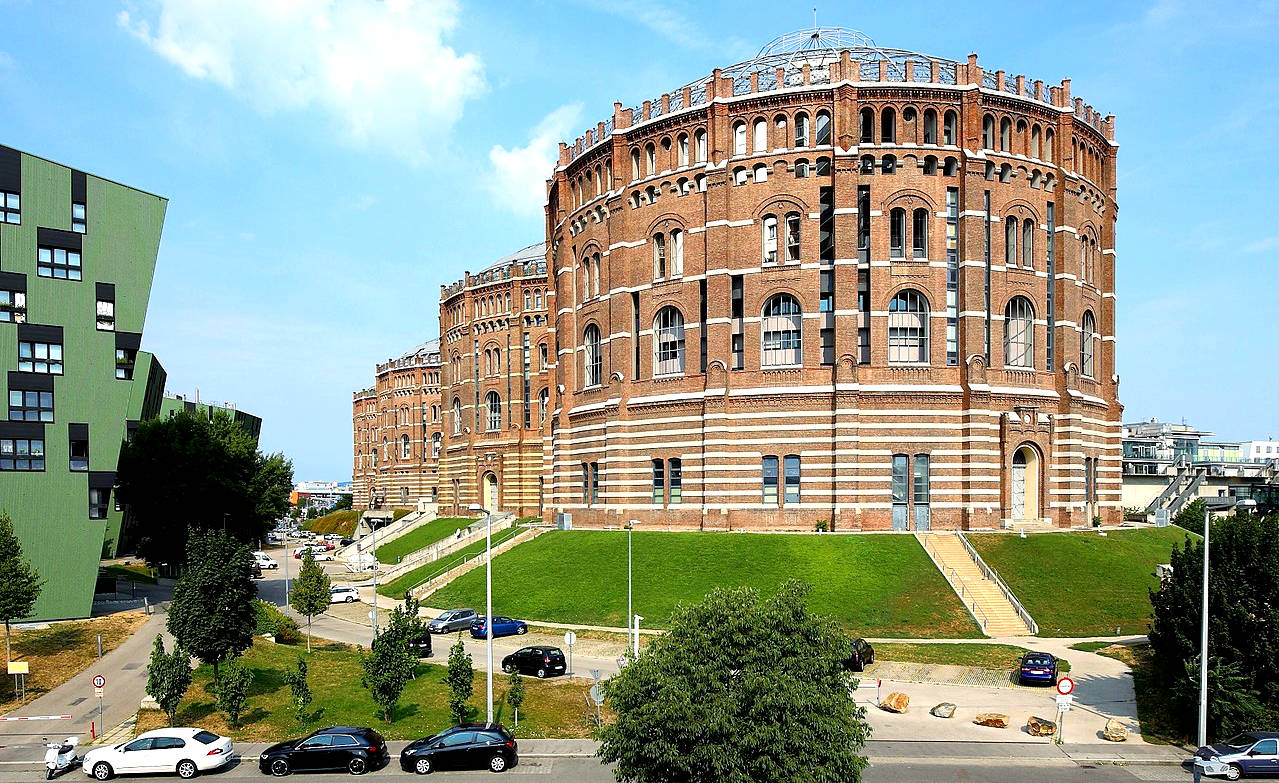
AUSTRIA
- A nicely converted row of gasholders, turned into accommodation to
preserve history.
AUSTRALIA
Gasholders, though once common, have become rare in Australia. Most gasworks within the country were demolished or repurposed, and few gasometers remain because of this. A good example of a largely intact gasometer is located at the Launceston Gasworks site in Tasmania. Though the gas bell has been removed, all other components are intact. The remains of two older 1860s gasometers are also visible on site but only the foundations remain. In Sydney a beautiful ornate gasometer frame can be seen from the platform of the Macdonaldtown railway station which was built above the access tunnels of the adjoining gasworks site.
In Queensland, the Gasworks Newstead is a commercial, residential, and retail development adjoining the river at Newstead, Brisbane, opening in 2013, built around a now heritage-listed 1887 gas holder. Only the frame remains, inside of which is a plaza used as a public recreation zone and for occasional special events such as markets or concerts. At dusk each day a dynamic lighting display illuminates the frame. The former industrial site on the inner-city fringe became an urban renewal zone for upmarket housing centred on the Gasworks zone.
For many years, a huge gasholder towered over the Arden Street Oval, the home ground of the North Melbourne Football Club in the Victorian Football League. Television coverage of Australian Rules football matches played at the famous ground showed the gasholder dominating the landscape. It was demolished in late 1977/early 1978.
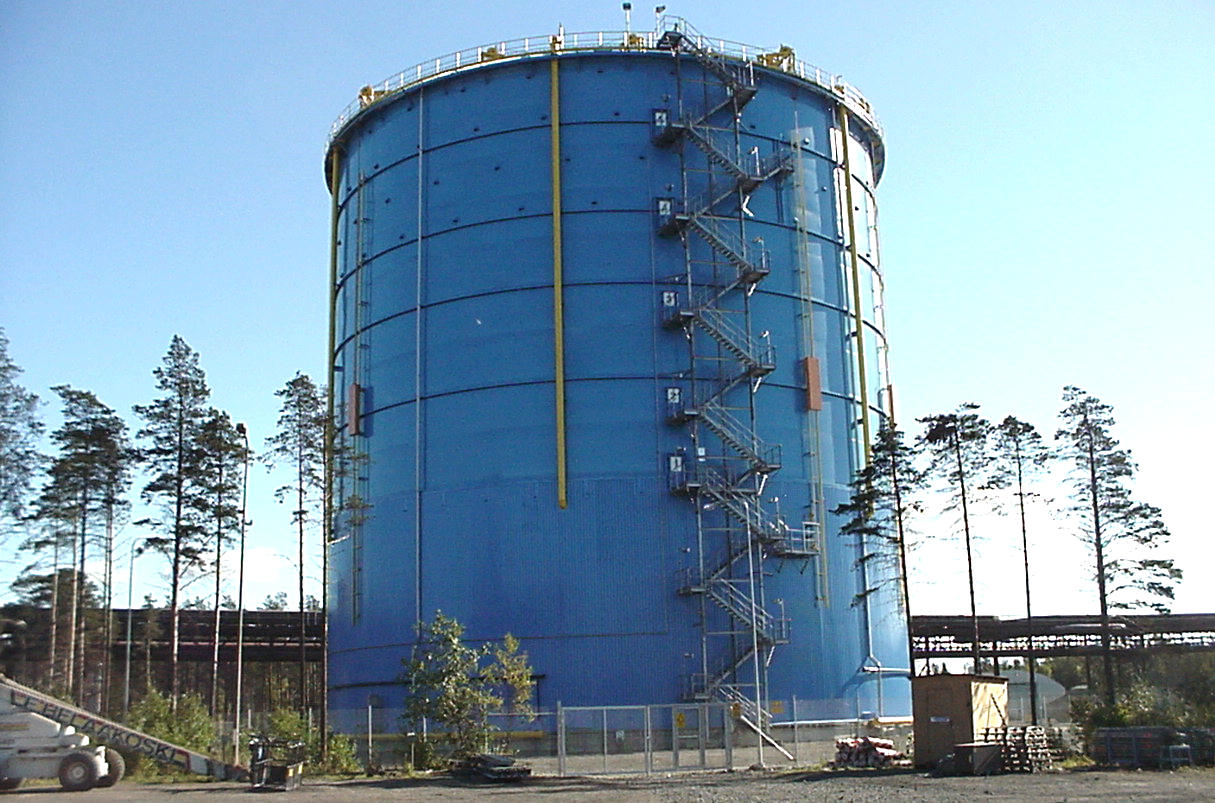
FINLND
- A thin shell gasometer.
ARGENTINA
This gasholder once operated by Gas del Estado is located in Villa Maipú, Partido de San Martín, Argentina. It was built in 1948 by MAN, and it was used to store coke gas produced by a near factory named Usina Corrales. With a total height of 85 meters and a diameter of 54 meters it was operational for short period of time until in 1954 it was decommissioned. The structure remains in place and it is property of Gas Natural Fenosa. HISTORY Before the mid-20th century coal gas was produced in retorts by heating coal in the absence of air, the process being known as coal gasification. Coal gas was first used for municipal lighting, the gas being passed through wooden or metal pipes from the retort to the lantern. The first public piped gas supply was to thirteen gas lamps installed along the length of Pall Mall, London, in 1807. The credit for this installation goes to the German inventor and entrepreneur Frederick Albert Winsor.
Digging up streets to lay pipes required easements, and this delayed both further installation of street lighting, and the installation of gas for domestic illumination, heating and cooking.
William Murdoch joined Boulton and Watt, at the Soho manufactory in Birmingham in 1777, and in 1792 he built a retort to heat coal to produce the gas that illuminated his home and office in Redruth. His system lacked a storage method until James Watt Junior adapted a Lavoisier gazomètre for this purpose. A gasometer was incorporated into the first small gasworks built for the Soho manufactory in 1798.
William Murdoch and his pupil Samuel Clegg went on to install retorts in individual factories and other workplaces. The earliest was in 1805, at Lee & Phillips, Salford Twist Mill, where eight gas holders were installed. This was shortly followed by one in Sowerby Bridge, constructed by Clegg for Henry Lodge.
The first independent commercial gas works was built by the Gas Light and Coke Company in Great Peter Street, Westminster, in 1812, with wooden pipes laid to gas lights on Westminster Bridge on New Year's Eve in 1813. Public gas lights were seen as a means to reduce crime and until the 1840s they were regulated by police authorities.
Because of safety concerns expressed by the Royal Society, the size of gas holders was limited to 6,000 cubic feet (170 m3) and they were enclosed in gasometer houses. In fact any small leak from an enclosed gas holder created a potentially explosive build-up of air and gas within the enclosing house, presenting a far greater danger than the original leak did; putting houses around gas holders was discontinued in the UK. In the United States, however, where gas needed to be protected from much more extreme weather, gasometer houses continued to be built and were architecturally decorative.
The telescopic gas holder was first invented in 1824. The cup and dip (grip) seal was patented by Hutchinson in 1833, and the first working example was built in Leeds. Gas holders were then built all around the UK in great numbers starting in the 1850s. The first were the two-lift column-supported type; later they could have four lifts, being frame-guided, and they could be retrofitted with an additional flying lift. The large gas holders at Kings Cross, London, were built in the 1860s.
William Gadd of Gadd & Mason in Manchester invented the spirally guided gas holder in 1890. Instead of external columns or guide frames, his design operated with spiral rails. The first commercial design was built in Northwich, Cheshire, in the same year. By the end of the 19th century most towns in Britain had their own gas works and gas holders.
The years between the two world wars were marked by improvements in storage, especially the waterless gas holder, and in distribution, with the advent of 2-to-4-inch (50 to 100 mm)
steel pipes to convey gas at up to 50 psi (340 kPa) as feeder mains to the traditional cast-iron pipes. Municipal gas works became superfluous in the later 20th century, but gas holders and production plant were still in use in steel works in 2016.
Please
use our A-Z
INDEX to navigate this site
This
website is provided on a free basis as a public information service.
copyright © Climate Change Trust 2021. Solar
Studios, BN271RF, United Kingdom.
|








